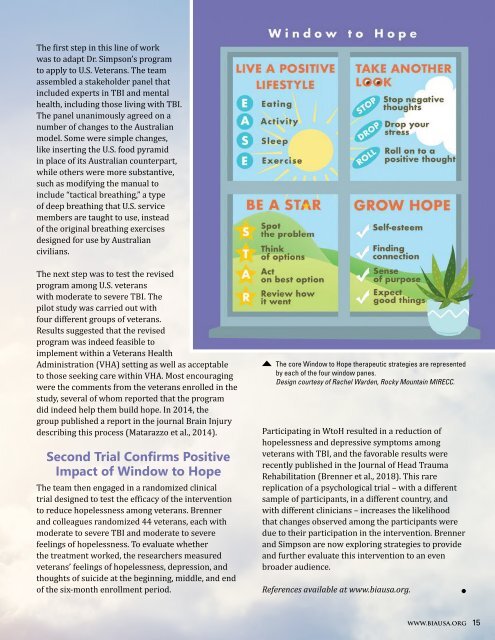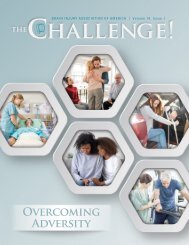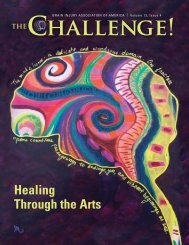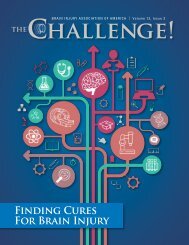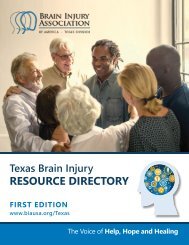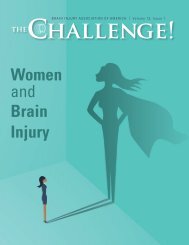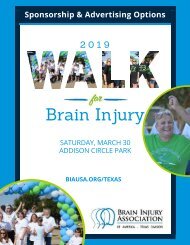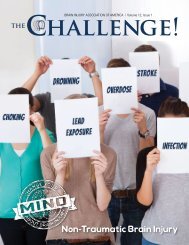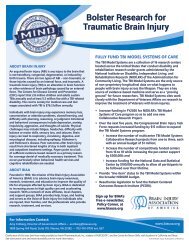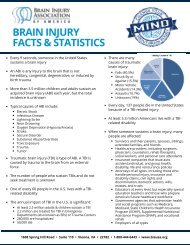THE Challenge Vol. 12 Iss. 2 Research
Create successful ePaper yourself
Turn your PDF publications into a flip-book with our unique Google optimized e-Paper software.
The first step in this line of work<br />
was to adapt Dr. Simpson’s program<br />
to apply to U.S. Veterans. The team<br />
assembled a stakeholder panel that<br />
included experts in TBI and mental<br />
health, including those living with TBI.<br />
The panel unanimously agreed on a<br />
number of changes to the Australian<br />
model. Some were simple changes,<br />
like inserting the U.S. food pyramid<br />
in place of its Australian counterpart,<br />
while others were more substantive,<br />
such as modifying the manual to<br />
include “tactical breathing,” a type<br />
of deep breathing that U.S. service<br />
members are taught to use, instead<br />
of the original breathing exercises<br />
designed for use by Australian<br />
civilians.<br />
The next step was to test the revised<br />
program among U.S. veterans<br />
with moderate to severe TBI. The<br />
pilot study was carried out with<br />
four different groups of veterans.<br />
Results suggested that the revised<br />
program was indeed feasible to<br />
implement within a Veterans Health<br />
Administration (VHA) setting as well as acceptable<br />
to those seeking care within VHA. Most encouraging<br />
were the comments from the veterans enrolled in the<br />
study, several of whom reported that the program<br />
did indeed help them build hope. In 2014, the<br />
group published a report in the journal Brain Injury<br />
describing this process (Matarazzo et al., 2014).<br />
Second Trial Confirms Positive<br />
Impact of Window to Hope<br />
The team then engaged in a randomized clinical<br />
trial designed to test the efficacy of the intervention<br />
to reduce hopelessness among veterans. Brenner<br />
and colleagues randomized 44 veterans, each with<br />
moderate to severe TBI and moderate to severe<br />
feelings of hopelessness. To evaluate whether<br />
the treatment worked, the researchers measured<br />
veterans’ feelings of hopelessness, depression, and<br />
thoughts of suicide at the beginning, middle, and end<br />
of the six-month enrollment period.<br />
The core Window to Hope therapeutic strategies are represented<br />
by each of the four window panes.<br />
Design courtesy of Rachel Warden, Rocky Mountain MIRECC.<br />
Participating in WtoH resulted in a reduction of<br />
hopelessness and depressive symptoms among<br />
veterans with TBI, and the favorable results were<br />
recently published in the Journal of Head Trauma<br />
Rehabilitation (Brenner et al., 2018). This rare<br />
replication of a psychological trial – with a different<br />
sample of participants, in a different country, and<br />
with different clinicians – increases the likelihood<br />
that changes observed among the participants were<br />
due to their participation in the intervention. Brenner<br />
and Simpson are now exploring strategies to provide<br />
and further evaluate this intervention to an even<br />
broader audience.<br />
References available at www.biausa.org.<br />
www.biausa.org 15


